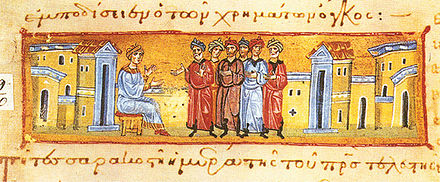The Greek Legend of Josaphat and Barlaan, who are believed to have survived around the 3rd-4th century in India, has been ascribed to John Damascene who wrote it around 750 B.C. (Although some sources cite that this is actually originally written by the Georgian monk, Euthymios in the 11th century).
The story traces its origin to a Manichaean tract produced in Central Asia. In the Preparer’s Notes, it has been established that this work has startling similarities with the Tale of Buddha, thus Josaphat and Baraan is referred to
as the Christianized version of Buddha’s life, with Josaphat reaching enlightenment through he love of Jesus Christ. (Woodward, G.R. & H. Mattingly, 1914)
“Barlaan at Josaphat,” printed in the Philippines by Fr. Antonio de Borja, S.J. in 1708 and 1712–although a translation–is considered by researchers as the first novel in Tagalog. (J. Villa Panganiban, et al., 1987)
***

Barlaan and Josaphat, wikipedia
King Abenir (Abenner or Avenier) reigns over a vast Indian Kingdom outstretched beyond the lands of Egypt. He lives in luxury and worldly honors, and is known for his bravery and victory in battles. Yet despite being mighty in wealth and power, his happiness is marred, for he has no heir to inherit his throne, kingdom, and glory.
Meanwhile, he learns that noblemen and senators have abandoned their luxurious lives and started laying their lives for Christ’s sake. Those who embrace the monastic life are growing in number. Hence, the king starts passing on decrees forcing Christians to renounce their religions, and later mastered various methods of torture to persecute them. Many of the followers who are weak in spirit are unable to endure the torture and yield to the king. The others who rebuke him suffer and become martyrs. The threatened few seek refuge in the deserts and mountains.
The king rules for many years and in this terrible state of error, the queen bears a child. The comely babe, they name Josaphat (Ioasaph). The king is filled with joy, and orders his men to gather his people to celebrate his son’s
birthday. Although in shroud of fear, the people come, bringing offerings according to what each man has in store. King Abenir’s joy is however short-lived when he learns from the oracles of kings that his son will embrace the Christian faith:
“From that which I learn from the courses of the stars, O king, the advancement of the child, now born unto thee, will not be in thy kingdom, but in another, a better and a greater one beyond compare. Methinketh also that he will embrace the Christian religion, which thou persecutest, and I trow that he will not be disappointed of his aim and hope.” thus spoke the astrologer (Part III, Online Medieval Library).
King Abenir’s wrath and disillusionment is such as to have his men build a castle for his only son in a secluded city. There Josaphat (Ioasaph) lives, devoid of any contact from the outside world, except for instructors, servants, and guards–whom the king thinks fit to serve him. The young prince grows to manhood.
Meanwhile, in the wilderness of Senaar, there lives a hermit saint. This elder’s name is Barlaan (Barlaam). Upon witnessing an apparition, Barlaan leaves for the young prince Josaphat’s palace. In disguise as a merchant, he starts imparting the Christian teachings and works to Josaphat until the latter accepts the faith and finally gets baptized.
When King Abenir discovers his son’s baptism, he is outraged. But after six years of his son’s persistent urging and encouragement, the king himself gets baptized. Not long after, the king dies, and Josaphat honors his body by burying him in a sepulchre where the devoted men lay and clothing him in a robe of penitence.
After erecting and establishing a church, Josaphat leaves his father’s land and entrusts the kingdom to a faithful servant and follower, Barachias. He embarks in a journey in search of true happiness and a life unobstructed by worldly confusions. Enduring sundry misfortunes and hardships, Josaphat finally finds his friend, Barlaan. The rest of their lives they devote in
living godly lives and venerating the Lord. They took to an ascetic lifestyle
until Barlaan’s death. Two years later, Josaphat followed.
The news of their death reaches King Bacharias, upon which he orders the remains of Barlaan and Josaphat to be brought back to India and buried in the church that Josaphat has built. Since then, the believers considered Barlaan and Josaphat saints:
“Barachias, making no delay, set forth with a mighty host, and arrived at the cave, and beheld their sepulchre, and wept bitterly over it, and raised the gravestone. There he descried Barlaam and Ioasaph lying, as they had been in life. Their bodies had not lost their former hue, but were whole and uncorrupt, together with their garments. These, the consecrated tabernacles of two holy souls, that sent forth full sweet savour, and showed naught distressful, were placed by King Barachias in costly tombs and conveyed by him into his own country.” (Part XL, Online Medieval Library)
- Barlaam and Ioasaph, St. John of Damascus, BiblioBazaar, LLC : 2008
- Barlaan at Josaphat, Lope de Vega, Ateneo de Manila University Press (Quezon City) : 2003
- St. John Damascene: Barlaam and Ioasaph, Woodward, G.R. & H. Mattingly (Ed. & Trans.) Harvard University Press, Cambridge MA, 1914 ( ISBN 0-674-99038-2).
ONLINE References:
- http://en.wikipedia.org/wiki/Barlaam_and_Josaphat
- http://www.hup.harvard.edu/catalog/L034.html
- http://omacl.org/Barlaam/ (electronic edition was edited, proofed, and prepared by Douglas B. Killings (DeTroyes@EnterAct.COM), November, 1996.)

